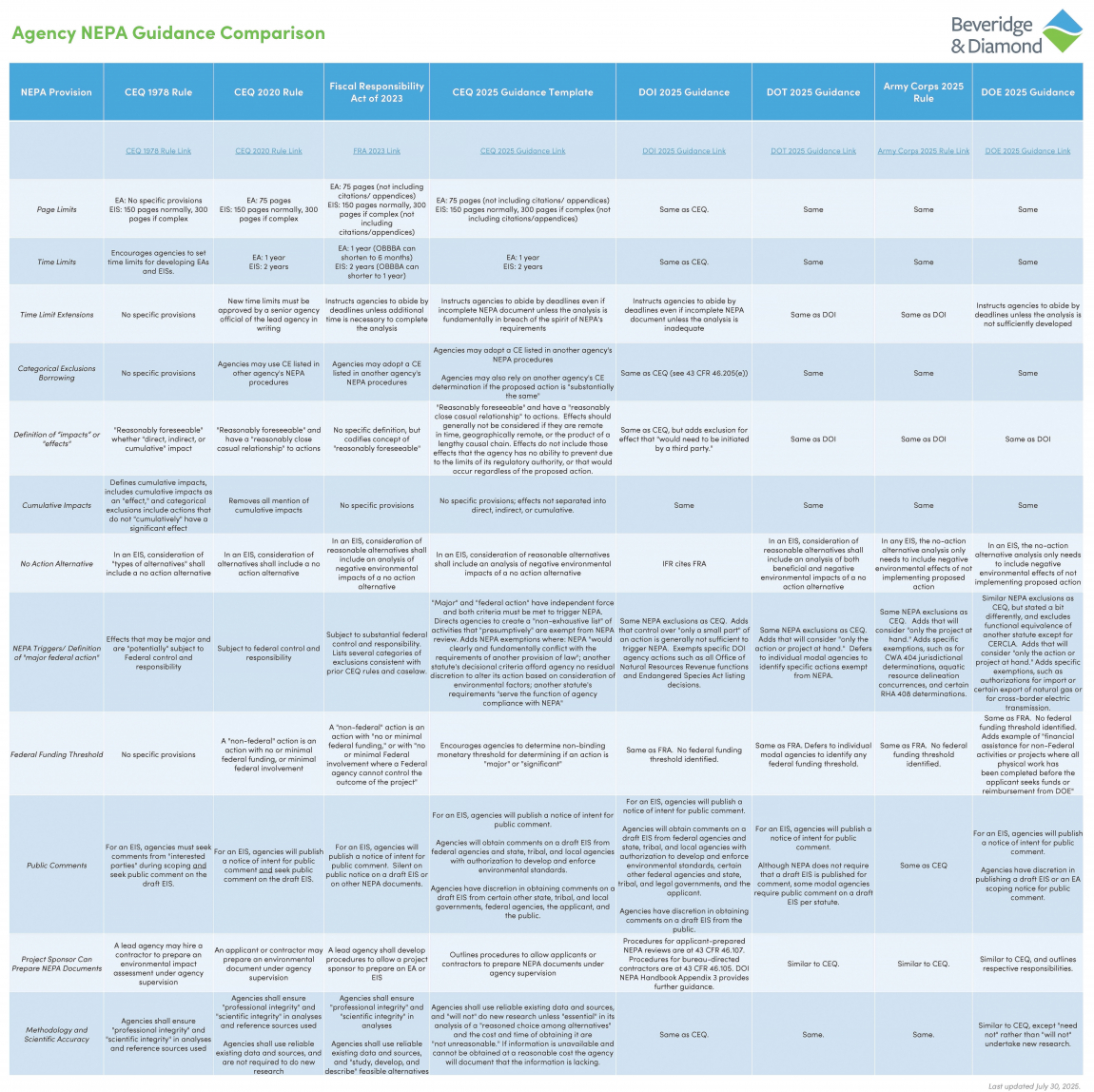Key Takeaways
- What happened: Over the last few weeks, individual federal agencies have issued interim final rules (IFRs) to largely rescind their existing NEPA regulations. Agencies have replaced those regulations with a mixture of slimmed-down regulations and non-binding guidance/manuals/handbooks.
- Major Streamlining: Following CEQ’s lead, agencies are making major changes to NEPA processes to speed up and simplify reviews. There are some variations in agency approaches, but they all follow the theme of expediting NEPA compliance and final decision-making.
- Who this affects: Companies, States, and other sponsors undertaking projects that require federal permits, involve federal funding, occur on federal lands, or otherwise may trigger NEPA review.
- What you should do: Stay informed about changes to relevant agency NEPA provisions and submit public comments where applicable. Many agencies are accepting comments on their IFRs until August 4, 2025. Agencies have indicated that even more NEPA changes are forthcoming.
Background
The National Environmental Policy Act (NEPA) took effect in 1970. The Council on Environmental Quality originally issued non-binding guidance to assist agencies in developing implementation procedures. In 1977, to standardize NEPA procedures across the federal government, President Carter issued an executive order requiring CEQ to promulgate regulations that would be binding on federal agencies.
CEQ promulgated binding regulations in 1978 that largely went untouched for over 40 years. Agencies issued their own supplemental regulations that incorporated CEQ’s regulations by reference. But recently, NEPA has not been immune to policy pendulum swings across administrations. The first Trump administration promulgated new CEQ regulations in 2020 that provided the first overhaul of the 1978 regulations. Congress then passed the Fiscal Responsibility Act of 2023 (FRA), which codified a number of the CEQ 2020 rule provisions into law while streamlining other permitting requirements. The Biden administration then issued another overhaul of CEQ NEPA regulations in 2024, trumpeting concepts like climate change, environmental justice, and indigenous knowledge.
Over the last year, courts have driven major NEPA changes, upon which the latest agency actions seek to capitalize. First, multiple courts held that CEQ lacks the authority to issue binding NEPA regulations. In light of those rulings, the administration has used the good cause exception of the Administrative Procedure Act to rescind CEQ’s binding regulations through an interim final rule (IFR) without typical prior notice-and-comment. The administration has since directed other agencies to also rescind their own NEPA regulations and issue non-binding guidance in place of rulemakings where possible. Most recently, the Supreme Court’s Seven County decision afforded agencies greater discretion in determining the scope of their NEPA reviews and focusing on the effects of “the project at hand.”
Agencies have responded by issuing a flurry of IFRs over the last few weeks, rescinding most of their NEPA regulations. Agencies have retained binding regulations to address NEPA topics most beneficial to project proponents, including categorical exclusions, emergencies, and third-party preparation of NEPA documents. Agencies have shifted the majority of their NEPA provisions to separate guidance documents, issued concurrently with the IFRs.
Although the agencies’ IFRs are immediately effective, agencies are still accepting public comments on many IFRs and agency guidance. For example, the U.S. Department of the Interior (DOI), U.S. Department of Transportation (DOT), U.S. Army Corps of Engineers (USACE), and U.S. Department of Energy (DOE)—encompassing their respective subagencies—as well as other agencies, are accepting public comment until August 4, 2025.
Agencies Adhere to CEQ Guidance Template
Although CEQ rescinded its binding regulations, it issued a guidance template that agencies can use while updating their own NEPA procedures. The guidance will assist agencies in adopting replacement procedures to expedite NEPA reviews, without a gap after rescinding their binding regulations. Agencies have quickly adopted many of the provisions suggested in the guidance template, with some differences.
For example, DOI, DOT, USACE, and DOE have all issued guidance or updated their regulations adopting almost word-for-word the CEQ guidance template’s provisions on page limits of environmental impact statements (EISs) and environmental assessments (EAs). All have also adopted nearly identical definitions of “impacts,” “major federal actions,” and “non-federal actions.” They have also adopted similar language around project sponsors and analytical methodologies.
Agencies have discretion in using the template, however, and some have already chosen to deviate from CEQ’s guidance template in other areas.
For example, the FRA statute requires agencies to include an analysis of the negative environmental impacts of a no-action alternative in an EIS. While CEQ’s guidance template largely mirrors the FRA, the agencies have adopted slightly different interpretations. DOT’s guidance is to include an analysis of both beneficial and negative environmental impacts of a no action alternative, while USACE’s and DOE’s guidance suggests they only needs to consider negative environmental impacts of not selecting the proposed action.
Agencies’ NEPA Procedures Stripped Down to Statutory Requirements in Some Instances, While Going Beyond in Others
Public Comments: Some agencies are forgoing longstanding public comment policies, particularly on a draft EIS, to include only the public input required by statute. The CEQ 1978 rule required agencies to seek comments from "interested parties" during both the scoping and the public comment period for the draft EIS. The CEQ 2020 rule went one step further and required agencies to publish an EIS notice of intent for public comment while maintaining the requirement to seek comment on the draft EIS. The FRA codified the requirement for agencies to publish an EIS notice of intent for public comment.
Yet, new CEQ and agency guidance suggests agencies do not need to seek comment on a draft EIS from the public, the applicant, or certain agencies without authority to develop and enforce environmental standards for the project. USACE’s new procedures largely follow CEQ’s guidance template, while DOI, DOT, and DOE take slightly different approaches; DOI provides for comments from a broader set of agencies and from the applicant (but not the public), while DOE and DOT make all public comment discretionary (subject to statutory requirements identified by DOT unique to surface transportation projects).
Categorical Exclusion (CE) Borrowing: CEQ and agency guidance, on the other hand, go beyond what is expressly authorized by statute in borrowing of other agencies’ CEs. Under new guidance, even without adopting another agency’s CE, agencies can nevertheless “rely on the agency’s determination” that a CE applies to the action at issue, provided that it is substantially the same as the action for which the other agency applied a CE.”
Time limit extensions: The FRA codified a one-year deadline for completing an EA and a two-year deadline for completing an EIS, unless an extension is “necessary” to complete the analysis. The recently enacted reconciliation legislation allows project sponsors to cut those times in half by paying the government 125% of anticipated NEPA document preparation or oversight costs. The CEQ guidance template goes a step further and instructs agencies to abide by those deadlines, even if the NEPA document is incomplete, unless the analysis is “fundamentally in breach of the spirit of NEPA’s requirements.” Agencies have adopted similar, but slightly different, language in their newly issued non-binding guidance and updated regulations. For example, DOI, DOT, and USACE have all instructed their agencies to abide by the deadlines unless the analysis is “inadequate.” DOE guidance abides by the deadlines unless the analysis is “not sufficiently developed.”
Next Steps
Although streamlining NEPA processes will be a welcome change for many project proponents, some of these new approaches are novel and have not yet faced litigation. Agency staff will need time to adjust to these new requirements, a task complicated by the current shrinking of the federal workforce. The removal of binding regulations may also lead to inconsistencies across agencies and within different offices of a single agency. Project proponents should be aware that agency approaches to NEPA are in flux and of the ways that these new procedures could affect NEPA reviews and any associated litigation.






 />i
/>i


